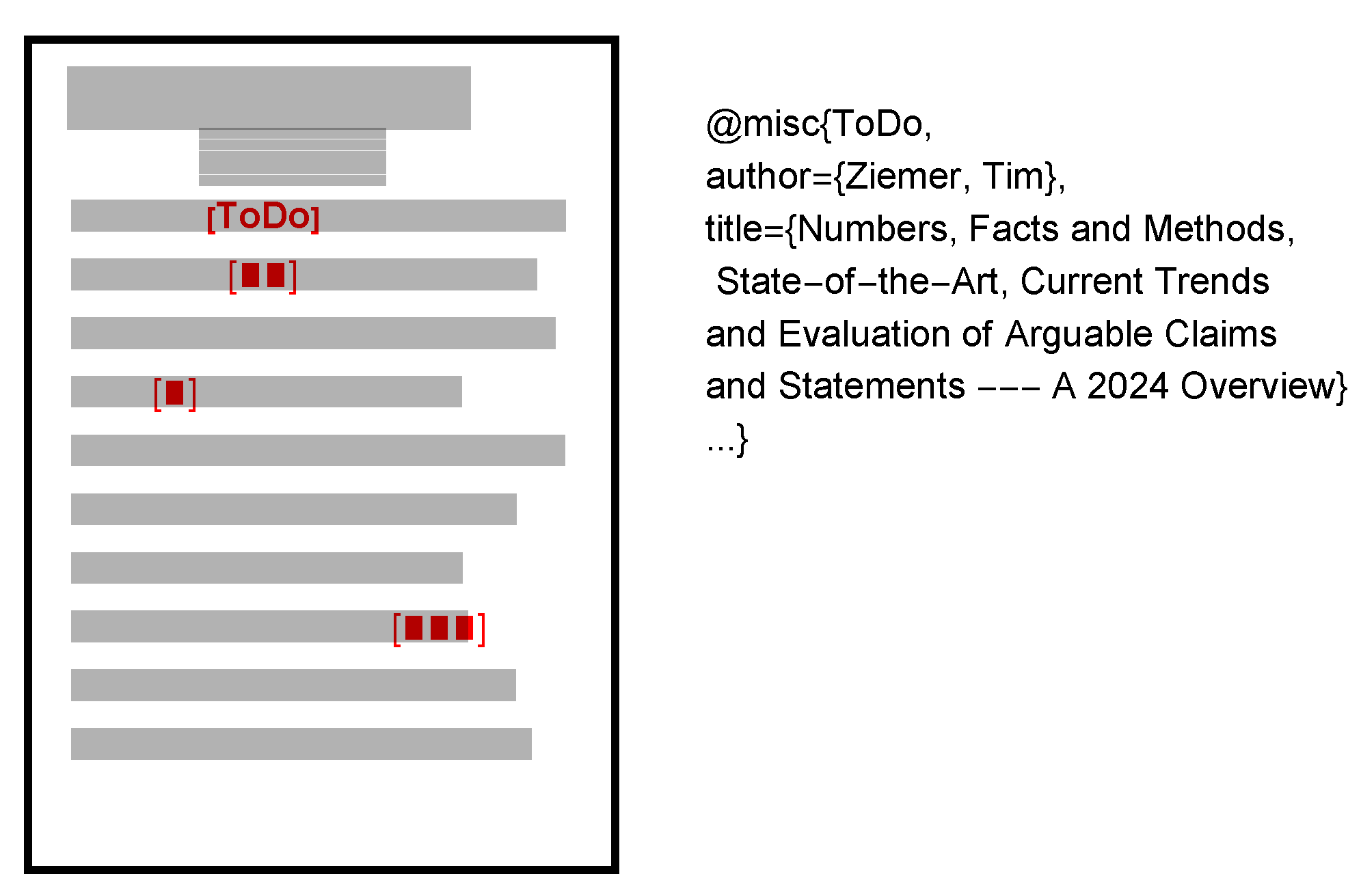Submitted:
30 November 2023
Posted:
05 December 2023
You are already at the latest version
Abstract
Keywords:
1. Introduction
2. Method
 and BibTeX, simply use “ToDo” as a citation key. Personally, I like to write “ToDo” as a comment wherever I need to add, improve, or correct a passage afterward. Before submitting the manuscript, I search for “ToDo” and make all necessary corrections.
and BibTeX, simply use “ToDo” as a citation key. Personally, I like to write “ToDo” as a comment wherever I need to add, improve, or correct a passage afterward. Before submitting the manuscript, I search for “ToDo” and make all necessary corrections.3. Results
4. Conclusion
References
- Stenhouse, L. What Counts as Research? British Journal of Educational Studies 1981, 29, 103–114. [Google Scholar] [CrossRef]
- Bertrand, Y.; Van den Abbeele, B.; Veneruso, S.; Leotta, F.; Mecella, M.; Serral, E. A Survey on the Application of Process Mining to Smart Spaces Data. Process Mining Workshops; Montali, M.; Senderovich, A.; Weidlich, M., Eds.; Springer Nature Switzerland: Cham, 2023; pp. 57–70. [CrossRef]
- Mozafari Mehr, A.S.; M. de Carvalho, R.; van Dongen, B. Detecting Complex Anomalous Behaviors in Business Processes: A Multi-perspective Conformance Checking Approach. Process Mining Workshops; Montali, M.; Senderovich, A.; Weidlich, M., Eds.; Springer Nature Switzerland: Cham, 2023; pp. 44–56. [CrossRef]
- Nagaiy, Y.; Guoz, J.; Sumiy, T.; Orlikz, P.; Mineno, H. Sub-1 GHz Wireless Coexistence of IEEE 802.15.4g and IEEE 802.11ah Using Hybrid CSMA/CA. International Journal of Informatics Society 2021, 13, 55–66. [Google Scholar]
- Ziemer, T.; Yu, Y.; Tang, S. Using Psychoacoustic Models for Sound Analysis in Music. Proceedings of the 8th Annual Meeting of the Forum on Information Retrieval Evaluation; ACM: New York, NY, USA, 2016; FIRE ’16; pp. 1–7. [Google Scholar] [CrossRef]
- Nordblom, N. Influence of Vocal Tract Constrictions on the Recorder Sound. Fortschritte der Akustik – DAGA 2023; , 2023; pp. 919–922.
- Sharp, T. Peer Review for Conference Proceedings versus Journals: is there a difference? JPhys+ 2017.
- Drott, M. Reexamining the role of conference papers in scholarly communication. J. Am. Soc. Inf. Sci 1995, 46, 299–305. [Google Scholar] [CrossRef]
- de Leon, F.L.L.; McQuillin, B. The Role of Conferences on the Pathway to Academic Impact. Journal of Human Resources 2020, 55, 164–193. [Google Scholar] [CrossRef]
- Currie, L.; Devlin, F.; Emde, J.; Graves, K. Undergraduate search strategies and evaluation criteria: Searching for credible sources. New Library World 2010, 111, 113–124. [Google Scholar] [CrossRef]
- de Vet, H.; Verhagen, A.; Logghe, I.; Ostelo, R. Literature research: Aims and design of systematic reviews*. Australian Journal of Physiotherapy 2005, 51, 125–128. [Google Scholar] [CrossRef] [PubMed]
- Viggiano, R.; Ault, M. Online library instruction for online students. Information Technology and Libraries 2001, 20, 135–138. [Google Scholar]
- Marrone, M.; Hammerle, M. An Integrated Literature Review: Establishing Relevance for Practitioners. Thirty Seventh International Conference on Information Systems; , 2006.

 .
.| Statement | Citation tag in 
|
|---|---|
| “The chase is better than the catch” | \cite{motörhead,scooter,ToDo} |
| “Video games are a growing market” | \cite{ToDo} |
| “Mosquitoes are amongst the deadliest animals” | \cite{mosquitoes,ToDo} |
| “World cancer toll rises” | ‘\cite{cancer,ToDo} |
| “sonification is a promising research trend” | \cite{ToDo} |
| “Deep learning in psychoacoustics is a research trend” | \cite{ToDo} |
| “Today, synthesizers are the most-used musical instruments” | \cite{ToDo} |
| “Light is more visible than sound” | \cite{ToDo} |
| “A number of studies deal with the topic” | \cite{example1,ToDo} |
Disclaimer/Publisher’s Note: The statements, opinions and data contained in all publications are solely those of the individual author(s) and contributor(s) and not of MDPI and/or the editor(s). MDPI and/or the editor(s) disclaim responsibility for any injury to people or property resulting from any ideas, methods, instructions or products referred to in the content. |
© 2023 by the authors. Licensee MDPI, Basel, Switzerland. This article is an open access article distributed under the terms and conditions of the Creative Commons Attribution (CC BY) license (http://creativecommons.org/licenses/by/4.0/).




